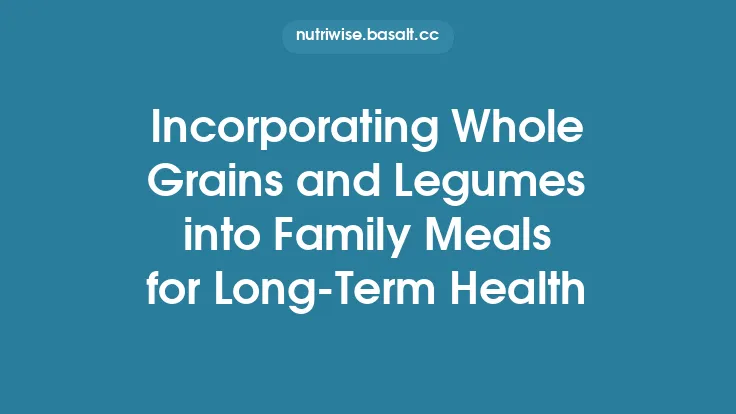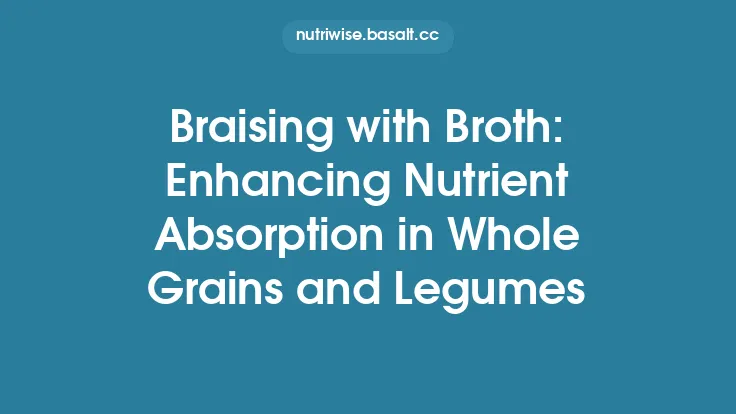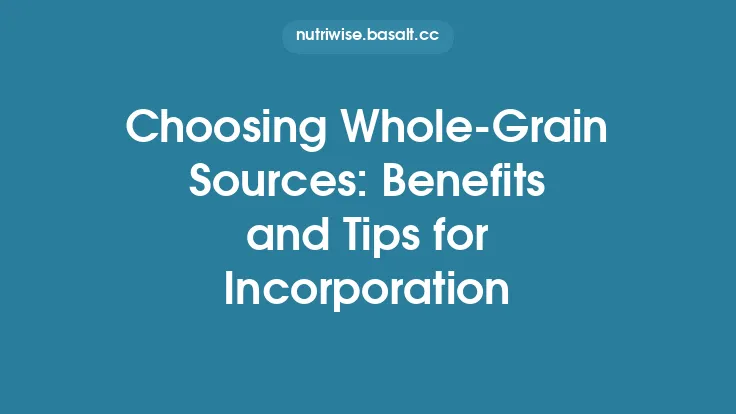Legumes and beans are the backbone of many plant‑based meals, offering a satisfying texture, hearty flavor, and a wealth of nutrients. Yet, achieving the perfect bite—neither mushy nor chalky—can be a challenge for even seasoned cooks. Below is a comprehensive guide to the essential techniques that will help you consistently produce perfectly cooked legumes and beans, while preserving their nutritional value and enhancing their natural taste.
Understanding the Science Behind Legume Structure
Legumes are composed of three main components: the seed coat (testa), the cotyledons, and the embryo. The seed coat contains pectic substances and hemicellulose, which give the bean its firmness. During cooking, heat and water cause these polysaccharides to gelatinize, softening the seed coat and allowing water to penetrate the interior. The rate and extent of this process depend on:
- Bean size and shape – larger beans (e.g., kidney beans) require more time than smaller ones (e.g., lentils).
- Age of the bean – older beans have tougher seed coats due to lignin accumulation, demanding longer cooking or pre‑soaking.
- pH of the cooking water – alkaline conditions accelerate softening, while acidic environments (e.g., adding tomatoes or vinegar) can delay it.
Understanding these variables lets you manipulate cooking conditions to achieve the desired texture.
Proper Storage and Shelf Life
Before cooking, ensure your legumes are stored correctly to maintain quality:
| Legume Type | Ideal Storage | Approximate Shelf Life |
|---|---|---|
| Dried beans (black, kidney, navy) | Airtight container in a cool, dark pantry | 1–2 years (still edible beyond, but texture may degrade) |
| Dried lentils (green, red) | Same as beans | 1 year |
| Split peas | Same as beans | 1 year |
| Chickpeas (dry) | Same as beans | 1–2 years |
| Fresh beans (green beans, edamame) | Refrigerated, 4 °C, in a perforated bag | 3–5 days |
| Cooked beans (refrigerated) | Airtight container | 4–5 days |
| Cooked beans (frozen) | Freezer‑safe bag, flat‑packed | 3 months |
Inspect dried legumes for signs of moisture, mold, or insect damage before use. Discard any that appear discolored or emit an off‑odor.
The Soaking Debate: When and How to Soak
Why Soak?
- Reduced cooking time – Soaking hydrates the seed coat, cutting active cooking time by up to 50 %.
- Improved digestibility – Soaking leaches out oligosaccharides (raffinose, stachyose) that can cause flatulence.
- Even texture – Hydrated beans cook more uniformly, reducing the risk of a mushy exterior with a hard core.
Soaking Methods
| Method | Procedure | Approx. Time | Best For |
|---|---|---|---|
| Cold soak | Cover beans with 3–4× volume of cold water; let sit at room temperature. | 8–12 h (overnight) | Most beans, especially larger varieties |
| Hot soak | Bring beans and water to a boil, remove from heat, cover, and let stand. | 1–2 h | When short on time; works well for lentils and split peas |
| Quick‑rinse | Boil beans for 2 min, drain, then soak in fresh water for 1 h. | 1 h (plus 2 min boil) | When you need a compromise between speed and texture |
| No‑soak | Directly cook beans in ample water, using pressure cooking to compensate. | 30–45 min (pressure) | Small beans (e.g., black-eyed peas) or when using a pressure cooker |
Tip: Discard the soaking water and rinse beans thoroughly before cooking. This removes the bulk of the flatulence‑inducing sugars and any surface debris.
Water Ratios and Cooking Vessels
Stovetop Cooking
- Standard ratio: 1 part dried beans to 3 parts water (by volume). Adjust to 4 parts for older beans.
- Pan selection: Use a heavy‑bottomed pot (e.g., enameled cast iron or stainless steel) to distribute heat evenly and prevent scorching.
- Skimming: During the first 10–15 minutes, foam may rise to the surface. Skim it off to keep the broth clear.
Pressure Cooking
- Ratio: 1 part beans to 2 parts water (the reduced liquid is absorbed under pressure).
- Time guide (high pressure):
- Small beans (black beans, navy beans): 8–10 min
- Medium beans (kidney, pinto): 10–12 min
- Large beans (cannellini, fava): 12–15 min
- Lentils (green, brown): 5–6 min
- Split peas: 6–8 min
- Natural release: Allow pressure to drop naturally for at least 10 minutes to prevent bean skins from rupturing.
Slow‑Cooker (Crock‑Pot)
- Ratio: 1 part beans to 4 parts water (slow cookers lose less moisture).
- Timing: 6–8 hours on low, 3–4 hours on high. Add a pinch of salt only after beans are tender; early salt can toughen skins.
Managing Acidity and Flavor Development
Acidic ingredients (tomatoes, citrus, vinegar) can inhibit softening if added too early. To balance flavor without compromising texture:
- Cook beans to near‑tenderness (about 90 % done) before introducing any acid.
- Add acid in the final 15–20 minutes of cooking, allowing flavors to meld while the beans finish softening.
- Consider using a small amount of baking soda (¼ tsp per cup of dried beans) if you need to speed up softening in an acidic broth. Use sparingly, as excess can affect flavor and nutrient retention.
Salt, Aromatics, and Seasoning Strategies
- Salt: Add coarse sea salt or kosher salt once beans are tender. This prevents the cell walls from tightening and ensures even seasoning.
- Aromatics: Bay leaves, whole cloves, peppercorns, and sprigs of thyme can be added at the start of cooking. They infuse subtle depth without overwhelming the bean’s natural flavor.
- Umami boosters: A splash of soy sauce, miso paste, or a small piece of kombu (seaweed) can enhance savory notes, especially in soups and stews.
Preventing Common Pitfalls
| Issue | Cause | Remedy |
|---|---|---|
| Hard center | Under‑cooking, old beans, insufficient water | Extend cooking time, add more water, use a pressure cooker |
| Mushy exterior | Over‑cooking, uneven heat distribution | Use a heavy‑bottomed pot, monitor closely, reduce heat once tender |
| Foamy broth | Released saponins | Skim foam early, rinse beans before cooking |
| Flatulence | Residual oligosaccharides | Soak and discard water, rinse well, consider adding a pinch of kombu during cooking |
| Discolored beans | High iron content reacting with acidic water | Use neutral pH water, add acid later in the process |
Advanced Techniques for Texture Control
Par‑Cooking and Freezing
- Cook beans to al‑dente (just shy of fully tender).
- Cool rapidly in an ice bath to stop cooking.
- Portion and freeze in airtight bags with a thin layer of cooking liquid.
When needed, drop frozen portions directly into soups or stews; they will finish cooking without becoming mushy.
Toasting Dried Beans
- Method: Lightly toast beans in a dry skillet over medium heat for 2–3 minutes before soaking.
- Effect: Enhances nutty flavor and can slightly reduce cooking time by opening the seed coat.
Sprouting Before Cooking
- Procedure: Soak beans for 8 hours, drain, and keep them in a breathable container at room temperature, rinsing twice daily for 1–3 days until sprouts appear.
- Benefit: Sprouted beans cook faster and have a slightly sweeter taste, while retaining most of their nutritional profile.
Nutrient Preservation Tips
While the article’s focus is on cooking technique, it’s worth noting that certain practices help retain the healthful compounds in legumes:
- Avoid over‑boiling – Prolonged high heat can degrade heat‑sensitive vitamins (e.g., folate). Aim for a gentle simmer once beans are hydrated.
- Retain cooking liquid – The broth contains leached minerals and soluble fibers. Use it as a base for soups, sauces, or grain cooking water.
- Minimal rinsing after cooking – Rinsing cooked beans removes some soluble nutrients; only rinse if you need to cool them quickly for a salad.
Incorporating Perfectly Cooked Legumes into Everyday Meals
Once you have mastered the fundamentals of cooking legumes, they become versatile building blocks:
- Salads: Toss cooled, al‑dente beans with leafy greens, chopped vegetables, and a simple vinaigrette.
- Stews & Chili: Add fully cooked beans toward the end of simmering to prevent disintegration.
- Purees & Dips: Blend cooked beans with olive oil, lemon juice, and herbs for hummus‑style spreads.
- Grain Bowls: Use beans as a protein source alongside quinoa, brown rice, or farro, drizzled with a flavorful broth.
Remember to season each component appropriately; beans absorb flavors well, so a well‑balanced seasoning plan elevates the entire dish.
Troubleshooting Quick Reference
| Symptom | Likely Cause | Quick Fix |
|---|---|---|
| Beans split open, skin separates | Over‑cooking or high heat | Reduce simmer intensity, check for doneness earlier |
| Beans remain hard after long cook | Old beans, insufficient water | Use fresh beans, add a pinch of baking soda, increase water |
| Cloudy cooking liquid | Starch release | Skim foam, rinse beans before cooking |
| Unpleasant “bean” odor | Incomplete soaking, stale beans | Discard soaking water, use fresh beans, add aromatics |
Final Thoughts
Perfectly cooked legumes and beans are achievable through a combination of proper storage, thoughtful soaking, precise water ratios, and attentive cooking methods. By mastering these evergreen techniques, you’ll enjoy beans that are tender yet intact, flavorful, and nutritionally robust—making them a reliable cornerstone of any plant‑based kitchen. Whether you’re preparing a quick weekday salad or a slow‑cooked stew, the principles outlined here will help you consistently deliver legume dishes that satisfy both the palate and the body.





